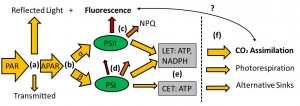FLUO-SYNTHESIS (Sept 2015 – Aug 2020). FLUO-SYNTHESIS (From Chlorophyll Fluorescence to Photosynthesis: Upscaling the Link) is a 5-year project funded by the Academy of Finland as part of an Academy Research Fellowship granted to Dr. Porcar-Castell. The goal of the project is to generate new mechanistic understanding and develop new methodology to quantitatively interpret solar-induced fluorescence in terms of photosynthesis.
The relationship between fluorescence and photosynthesis is well known at the leaf level, over short periods of time, and using active fluorescence methods (e.g. PAM fluorometers). Yet, interpretation of solar-induced fluorescence involves passive methods, seasonal changes, and canopy-scale measurements where leaves with multiple optical traits add to the integrated canopy signal. For example, the photosynthetic energy partitioning snapshot presented in the figure below is expected to differ across space, time, species, and stress factors affecting the relationship between fluorescence and carbon assimilation. In FLUO-SYNTHESIS we will characterize and model this variability.
Figure. Photosynthetic energy partitioning in a leaf. Incident photosynthetically active radiation (PAR) is partitioned between (a) reflected, transmitted and absorbed PAR (APAR). Pigment molecules responsible for the absorbed PAR (APAR) can be associated either with photosystem II (PSII) or photosystem I (PSI) (b) each with a relative absorption cross section: α (PSII), and β (PSI). Energy absorbed by PSII (c) can be used to run the Linear Electron Transport chain (LET), can be thermally dissipated as heat (NPQ), or re-emitted as chlorophyll fluorescence; similarly, energy absorbed by PSI (d) can be used to operate the LET chain, the Cyclic Electron Transport (CET), be thermally dissipated as heat (NPQ?), or re-emitted as chlorophyll fluorescence. Partitioning between LET and CET (e) can be used, among others, to adjust the ratio of ATP to NADPH depending on metabolic demands. Resulting ATP and NADPH is used (f): to assimilate atmospheric CO2 (carboxylation), to run photorespiration; or used by alternative energy sinks.
Budget: c. 1 M€.

